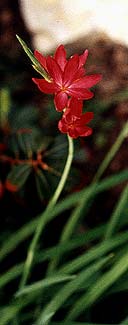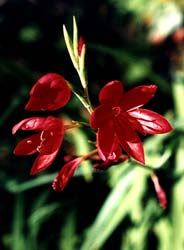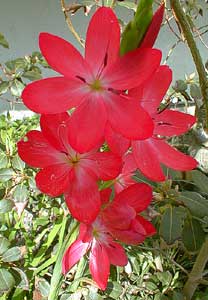
'Oregon Sunset' Crimson River Lily
Hesperantha coccinea was until a very few years ago called Schizostylis coccinea & the outdated name still seems to occur most often in catalog listings & on nursery tags, so bare in mind they're the same thing.
'Oregon Sunset' Kaffir Lily has bright salmon-red or coral-red flowers. The wild species is similarly bright red, & among white Africans it is increasingly called Crimson River Lily (occasionally "Crimson Flag"), in order to avoid the potentially offensive name "Kaffir" which Dutch-descended Afrikaaners in particular are prone to using with derogatory inflection equivalent to American white trash ejaculating racist epithets. Since the word literally means "Does Not Embrace Islam," those white Calvinist Afrikaaners are themselves Kaffirs, though that's not how they see it.
 To Americans & to large degree also to Brits, there is no such connotation & "Kaffir" means "something beautiful that is native of Africa" & if that became extended to include tribal peoples, then yes, they're beautiful too. The name is so well-known in England & North America exclusively as the name of a beloved flower that there's no chance in the forseeable future that nurseries will replace it, with politically correct intent, to some inadequate alternative such as the too-generic sounding "Berg Lily" or "River Lily" that just aren't catching on.
To Americans & to large degree also to Brits, there is no such connotation & "Kaffir" means "something beautiful that is native of Africa" & if that became extended to include tribal peoples, then yes, they're beautiful too. The name is so well-known in England & North America exclusively as the name of a beloved flower that there's no chance in the forseeable future that nurseries will replace it, with politically correct intent, to some inadequate alternative such as the too-generic sounding "Berg Lily" or "River Lily" that just aren't catching on.The rather more felicitous & precise "Crimson River Lily" only works for varieties such as 'Oregon Sunset' that approach the wildflower in color, & would not work for the numerous additional colors in cultivation. So Kaffir Lily it is, & Kaffir Lily it is apt to remain.
 Still, anyone visiting South Africa on vacation might like to know it isn't a word always heard in a friendly manner, & one shouldn't get all excited & shout out "Look! Kaffir lilies!" as it could sound terribly rude. While in Africa you might try calling it Khahlana as would Bantu peoples or Roorivierlelie as might polite Afrikaaners or just River Lily, just don't expect many to know what you meant outside of Africa.
Still, anyone visiting South Africa on vacation might like to know it isn't a word always heard in a friendly manner, & one shouldn't get all excited & shout out "Look! Kaffir lilies!" as it could sound terribly rude. While in Africa you might try calling it Khahlana as would Bantu peoples or Roorivierlelie as might polite Afrikaaners or just River Lily, just don't expect many to know what you meant outside of Africa.The usual descriptions for 'Oregon Sunset' state that it blooms in winter (November & December) which is a little later than most kaffirs which love Autumn best.
But ours in fact begins in Autumn; in 2002 it had a brief tepid blooming in August, then flowered in earnest beginning September, when the first two photos here were snapped, & it was still in full bloom December through February.
I thought it was finished blooming in March, but then it had another flush of bloom in April (2003), when the third photo was taken.
In our mild climate, then, it is an all-autumn & all-winter bloomer, with spring rebloom. I have to suppose they do not bloom this long in other zones, as such spectacularly lengthy period of flowering is not often mentioned. Puget Sound possesses a very even microclimate that even at the height of winter may fool kaffir lilies into thinking it's still autumn & they oughtn't stop blooming quite yet.
The evergreen foliage is a pleasant, restrained two foot tall spreading clump, with flowers raising three feet or higher. This & 'Mrs. Hegarty' Kaffir Lily are planted together & form a border between a Butternut Winter Hazel & a Rhododendron concinnum.
The River Lily grass has spread considerably & now blends into a patch of Lirope muscari 'Lilac Beauty' which is likewise evergreen, & begins blooming in summer but is still blooming nicely in early autumn when the kaffirs begin. Even when the Lirope lily-turf finishes blooming late in October, it sets black berries & remains quite an interesting contrast to the star-flowers of the autumn & winter blooming Kaffirs. Both the Kaffirs & the Lirope provide excellent dashes of leafy blades that never die back.
After three years the grass becomes so thick it begins to look untidy, with flower spikes more apt to tip over & the grass of uneven appearance. It needs to be dug up & divided to refresh it, though I tried thinning it out by hand-pulling sections of it, & cutting the rest back to start over. This treatment worked but the grow-back period was longer than I expected, so there was an interuption in its usually permanent presence.
Crimson River Lily as a small relative of gladiolas has its blossoms on spikes that rise from the grassy leaves. These spikes make excellent cut flowers. Each evening the beautiful flowers close up, & re-open when morning sun reaches them. Though native of South Africa they're very hardy in temperate regions just so long as temperatures do not drop below five or ten degrees F.
Hesperantha coccinea forma alba